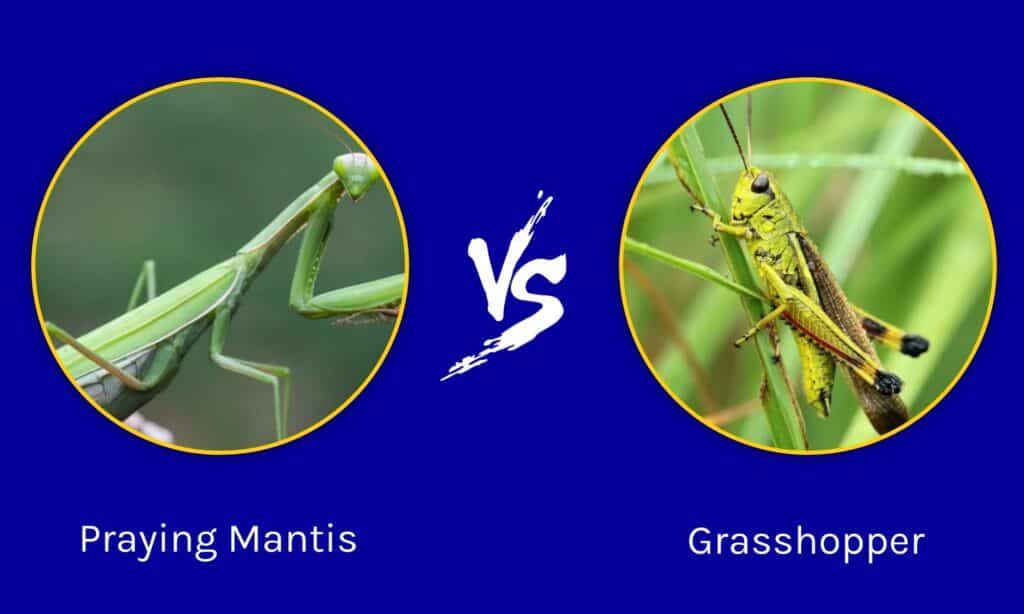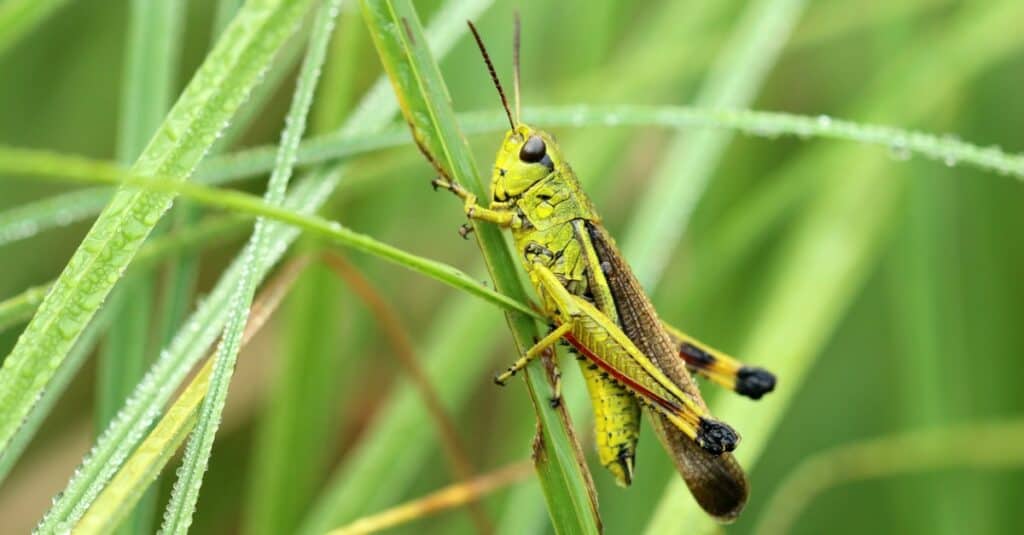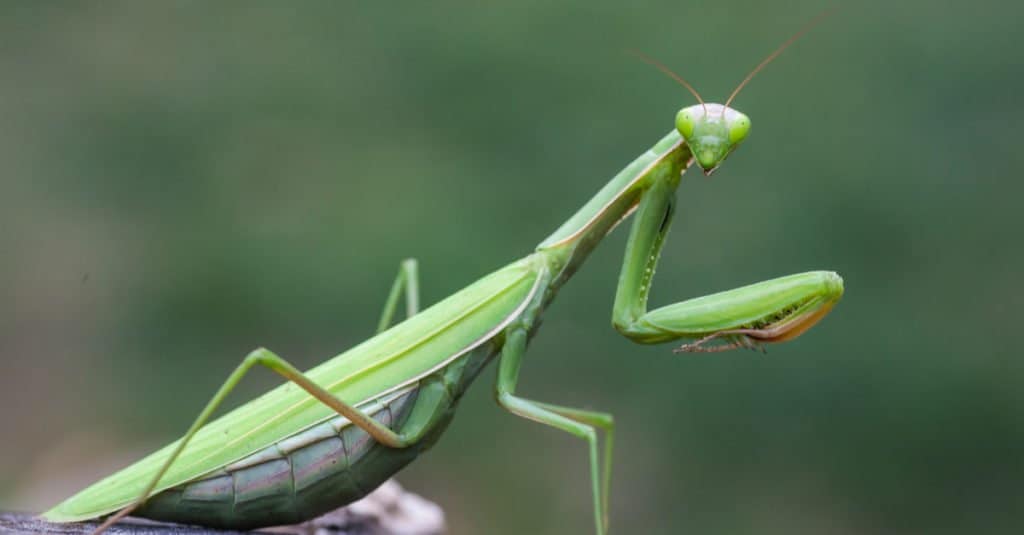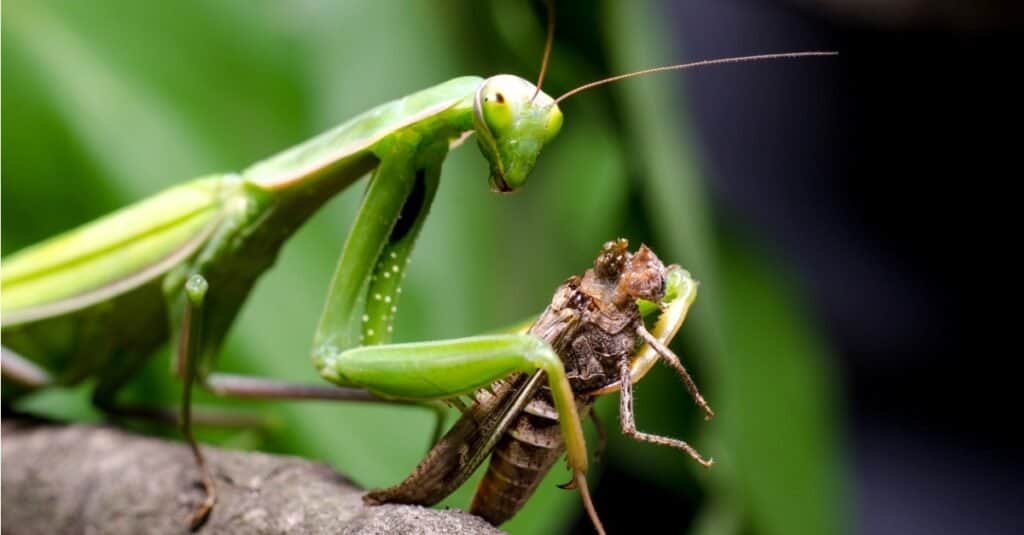There are thousands of grasshoppers, katydids, locusts, and crickets in the Orthopteran insect order. One of the most well-known Orthoptera insects is the grasshopper. Praying mantis belong to an order of insects called ‘Mantodea’ and a larger class called ‘Mantidae,’ or mantids. Although they do not belong to the same family, because of their appearance, they are often confused with one another. In this article, we aim to clear up any confusion as we explore 8 key differences between these two well-known bugs.
Praying Mantis vs Grasshopper: A Comparison

| Key Differences | Praying Mantis | Grasshopper |
| Size | 1 – 6 inches (25 – 150 mm) | 0.39 – 2.75 in (10 – 70 mm) |
| Colors | Green and Brown | Green or Brown |
| Physical Features | Small Head, Large Eyes, 3 Pairs of Legs, One Set of Wings | Short Antennae, Thick Back Legs, Large Eyes |
| Danger | Helpful in Eradicating Garden Pests, Non-Toxic, Rarely Bites | Cosmetic Damage To Plants, May Bite In Swarms, Diurnal, Non-Toxic |
| Diet | Obligate Carnivore; Insects and live Prey | Vegetarian, Plants, Mostly Grasses |
| Lifespan | 6 Months to 1 Year | 1 Year |
| Habitats | All Over The World, Primarily Asia; Any Green Space | Everywhere But Antarctica In Wet Or Dry Grassy, Low-Level Areas |
| Habits | Mostly Day Eaters: Females Eat Mates Occasionally | Comes Out During Day; Chirps and Eats Grasses |
Key Differences Between Praying Mantis vs Grasshopper

Grasshoppers have two jaws that allow it to grind its food.
©iStock.com/Eileen Kumpf
The twig-like appearance of these two insects might lead one to believe that they are related. However, grasshoppers and praying mantises have a number of key differences. Despite their closeness in color, they are not nearly as close as you might think. For example, whereas grasshoppers are classified under the Polyneoptera superorder, praying mantises are classified as a member of the Dictyoptera. Continue reading to learn more about the differences between the grasshopper and the praying mantis.
Appearance

Found worldwide in both temperate and tropical habitats, the praying mantis is known for its large, triangular head, bulbous eyes, and ability to grasp prey with its spiked forelegs.
©Ryzhkov Oleksandr/Shutterstock.com
Praying Mantis vs Grasshopper: Size
Grasshoppers range in length from 0.39 to 2.75 inches. The praying mantis’ body measures 1 to 6 inches long, with the average being 2 to 3.
Praying Mantis vs Grasshopper: Colors
Grasshoppers are typically brown and green. However, in addition to the standard shades of green and brown, grasshoppers can also be found in hues of orange, pink, and even crimson and blue, although this is a rare occurrence due to a genetic mutation.
When it comes to camouflage, a praying mantis has a green or brown tint that works well against prey and predators. Do you know that there are varieties of praying mantis that are white? Praying mantis species like the Orchid Mantis are among the most lovely insects on Earth!
Praying Mantis vs Grasshopper: Physical Features

Praying mantis isolated on white background.
©Nap1/Shutterstock.com
Large eyes, short antennae, and two pairs of tiny wings are all characteristics of grasshoppers. Their long, well-built back legs help them leap. They feature a hard capsule head with eating mouthparts. There is minimal differentiation between the head, the thorax, and the abdomen of the grasshopper, even though it contains these three sections. The insect’s thorax, on the other hand, is the bulkiest component.
The stick bug and the praying mantis are often mistaken for one other because of their resemblance to leaves and twigs. Small, triangular heads with huge, bulbous eyes and three pairs of legs distinguish mantis from other insects. Hunting is done by using a pair of front legs. The mantis uses these sharp spikes on its legs to grab prey. The insect’s name is often incorrectly written as “Preying Mantis.” However, it is not a coincidence that they are named after their ‘prayer-like’ posture. The name “praying mantis” is derived from the fact that they remain calm and quiet as they wait for prey (praying mantis). The animal’s front legs look to be clasped together in prayer while still. There are two wings on a praying mantis, but they are not meant to fly.
Characteristics

Grasshoppers have strong back legs used for high leaping.
©ervin herman/Shutterstock.com
Praying Mantis vs Grasshopper: Danger
Grasshoppers and other leaf-eating insects can cause big, uneven holes in leaves. It is unknown if these insects impact commercial crops, and the damage they cause to a home’s landscape is only superficial. If a large group of grasshoppers feels threatened, they may attack their prey. Grasshopper bites are not harmful. However, it’s possible that it will be uncomfortable at first.
Gardeners can benefit from praying mantes since they will eat grasshoppers, moths, and other insects in the area. A unique characteristic of the praying mantis is its ability to turn its head a full 180 degrees, a feat accomplished by no other insect. With their large, eyes, they have an exceptional ability to see. They are one of the most lethal ambush predators. Humans are feared by praying mantises, who flee if they are approached. There is no evidence that their bite is deadly or harmful, and they rarely do so. However, if you are bitten by one, you may experience considerable discomfort.
Praying Mantis vs Grasshopper: Diet
Green leafy plants tend to be the preferred food of grasshoppers, but they are not picky. They can eat moss, fungus, or even animal feces when they are done consuming green vegetation.
Although mantises love eating other insects such as grasshoppers, bees, fruit flies, crickets, and ants, they are obligate carnivores. Therefore, it’s common for praying mantises to also eat live tiny rodents, reptiles, and amphibians. They’ve even been observed to prey on hummingbirds! The average mature praying mantis consumes up to six insects every day.
Praying Mantis vs Grasshopper: Lifespan
Both insects have short lifespans. One year is the average lifespan of a grasshopper. A typical mantis’ lifespan is between six and twelve months.
Habitats and Habits

Praying Mantis, Mantis religiosa, eating a grasshopper.
©iStock.com/artas
Praying Mantis vs Grasshopper: Habitat
Every continent except Antarctica has grasshoppers, which number in the tens of thousands. These creatures can thrive in a wide range of environments, including dry areas with a lot of low-level vegetation. Asia is home to the majority of Praying Mantis species, with North America being home to 20 species. If there is a warm winter and enough greenery, praying mantids can be found all over the planet. Most of the time, praying mantids can be found in a garden, woodland, or any other type of green space.
Praying Mantis vs Grasshopper: Habits
You may see and hear grasshoppers throughout the day because they are diurnal. A grasshopper also sings. They generate a chirping sound by rubbing their hind legs against their wings. While mantis does not “sing,” they hiss when threatened or pursued.
One interesting habit of the female praying mantis is she occasionally engages in cannibalism after copulation with a male praying mantis. If a female mantis is starving or feels threatened by a male mantis, she is more likely to consume him. Males who mate with more than one female mantis have a higher chance of escaping cannibalism.
Wrapping Up Praying Mantis vs Grasshopper

Upon reviewing these two bugs, it is clear to see that aside from a few similarities, the praying mantis and grasshopper are two separate insects with distinct looks and habits. For example, the mantis grows to be larger on average than the grasshopper and has a much more twiggy appearance. Although they both come out mostly during the day, male mantises tend to come out at night to avoid larger predators. The grasshopper eats only greens, whereas the mantis is an insect-eater and even occasionally eats her own mate! Also, a grasshopper can be a nuisance to your garden, while the mantis might be quite beneficial. Either way, they are both vital insects to our ecosystem and are perfectly harmless to us.
The photo featured at the top of this post is © iStock.com/artas
Thank you for reading! Have some feedback for us? Contact the AZ Animals editorial team.






